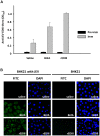Production of Japanese Encephalitis Virus Antigens in Plants Using Bamboo Mosaic Virus-Based Vector
- PMID: 28515719
- PMCID: PMC5413549
- DOI: 10.3389/fmicb.2017.00788
Production of Japanese Encephalitis Virus Antigens in Plants Using Bamboo Mosaic Virus-Based Vector
Abstract
Japanese encephalitis virus (JEV) is among the major threats to public health in Asia. For disease control and prevention, the efficient production of safe and effective vaccines against JEV is in urgent need. In this study, we produced a plant-made JEV vaccine candidate using a chimeric virus particle (CVP) strategy based on bamboo mosaic virus (BaMV) for epitope presentation. The chimeric virus, designated BJ2A, was constructed by fusing JEV envelope protein domain III (EDIII) at the N-terminus of BaMV coat protein, with an insertion of the foot-and-mouth disease virus 2A peptide to facilitate the production of both unfused and epitope-presenting for efficient assembly of the CVP vaccine candidate. The strategy allowed stable maintenance of the fusion construct over long-term serial passages in plants. Immuno-electron microscopy examination and immunization assays revealed that BJ2A is able to present the EDIII epitope on the surface of the CVPs, which stimulated effective neutralizing antibodies against JEV infection in mice. This study demonstrates the efficient production of an effective CVP vaccine candidate against JEV in plants by the BaMV-based epitope presentation system.
Keywords: Japanese encephalitis virus; bamboo mosaic virus-based vector; chimeric virus particles (CVPs); foot-and-mouth disease virus 2A; plant-made; vaccine.
Figures




Similar articles
-
Convenient Auto-Processing Vector Based on Bamboo Mosaic Virus for Presentation of Antigens Through Enzymatic Coupling.Front Immunol. 2021 Oct 14;12:739837. doi: 10.3389/fimmu.2021.739837. eCollection 2021. Front Immunol. 2021. PMID: 34721406 Free PMC article.
-
Induction of protective immunity in chickens immunized with plant-made chimeric Bamboo mosaic virus particles expressing very virulent Infectious bursal disease virus antigen.Virus Res. 2012 Jun;166(1-2):109-15. doi: 10.1016/j.virusres.2012.02.021. Epub 2012 Mar 1. Virus Res. 2012. PMID: 22406128
-
Stable Display of Artificially Long Foreign Antigens on Chimeric Bamboo mosaic virus Particles.Viruses. 2021 Mar 29;13(4):572. doi: 10.3390/v13040572. Viruses. 2021. PMID: 33805417 Free PMC article.
-
Fine mapping of a linear epitope on EDIII of Japanese encephalitis virus using a novel neutralizing monoclonal antibody.Virus Res. 2014 Jan 22;179:133-9. doi: 10.1016/j.virusres.2013.10.022. Epub 2013 Oct 31. Virus Res. 2014. PMID: 24184444
-
Points to consider in the development of a surrogate for efficacy of novel Japanese encephalitis virus vaccines.Vaccine. 2000 May 26;18 Suppl 2:26-32. doi: 10.1016/s0264-410x(00)00038-4. Vaccine. 2000. PMID: 10821970 Review.
Cited by
-
Production of complex viral glycoproteins in plants as vaccine immunogens.Plant Biotechnol J. 2018 Jun 11;16(9):1531-45. doi: 10.1111/pbi.12963. Online ahead of print. Plant Biotechnol J. 2018. PMID: 29890031 Free PMC article. Review.
-
Frontiers in the Standardization of the Plant Platform for High Scale Production of Vaccines.Plants (Basel). 2021 Sep 2;10(9):1828. doi: 10.3390/plants10091828. Plants (Basel). 2021. PMID: 34579360 Free PMC article. Review.
-
Identification of Crucial Amino Acids in Begomovirus C4 Proteins Involved in the Modulation of the Severity of Leaf Curling Symptoms.Viruses. 2022 Feb 28;14(3):499. doi: 10.3390/v14030499. Viruses. 2022. PMID: 35336906 Free PMC article.
-
Recent Advances in the Use of Plant Virus-Like Particles as Vaccines.Viruses. 2020 Feb 28;12(3):270. doi: 10.3390/v12030270. Viruses. 2020. PMID: 32121192 Free PMC article. Review.
-
Producing Vaccines against Enveloped Viruses in Plants: Making the Impossible, Difficult.Vaccines (Basel). 2021 Jul 13;9(7):780. doi: 10.3390/vaccines9070780. Vaccines (Basel). 2021. PMID: 34358196 Free PMC article. Review.
References
-
- Bhargava A., Shukla S., Ohri D. (2006). Chenopodium quinoa–An Indian perspective. Ind. Crops Prod. 23 73–87. 10.1016/j.indcrop.2005.04.002 - DOI
LinkOut - more resources
Full Text Sources
Other Literature Sources

